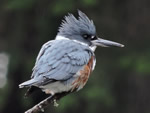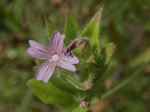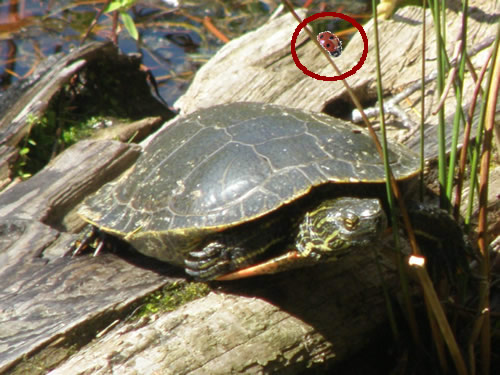 ___ ___
Welcome to our monthly celebration of nature and photography!
THIS MONTH:
» Quiz - Birds with red
» Five Things About...ladybirds
» Bird Food Recipe: Bird Bread
PLUS - mystery image |
snippets of nature | reader's contributions
|
|
|
 |
Stunning autumn colours and scenery in the Yukon welcome you this month.
|
|
 |
_ |
Where's Lily?
While you're reading this month, be sure to keep an eye out for Lily the Ladybug.
She's managed to hide in one of the photos, but which one?! |
|
|

In fall and winter, the starchy rhizomes (underground plant stems) of which
plant can
be peeled
and cooked like potatoes or dried and pounded into flour?
Compare your answer with the answer at the end of the newsletter.
|

 |
This month's mystery picture is a bit easier this month. What is it?
As usual, you'll find the answer at the end of the newsletter.
|
|
|
|
This month's quiz features birds which have some red, reddish or orange coloured markings.
Can you match the photos of the following birds with the correct name?
Make a list 1 through 8 and start matching! Good luck.
(Don't worry if you have some names left over as there are more names than photos.) |
| |
 |
_ |
 |
_ |
 |
_ |
 |
Bird 1 |
|
Bird 2 |
|
Bird3 |
|
Bird 4 |
|
|
|
|
|
|
|
|
|
|
|
|
|
|
Bird 5 |
|
Bird 6 |
|
Bird 7 |
|
Bird 8 |
|
|
|
|
|
|
|
American Robin |
|
Cedar Waxwing |
|
Northern Cardinal |
|
Northern Flicker |
| |
|
|
|
|
|
|
Red-breasted Nuthatch |
_ |
Rufous Hummingbird |
_ |
Red-winged Blackbird |
_ |
Ruby-crowned
Kinglet |
|
|
|
|
|
|
|
|
|
Spotted Towhee |
|
Varied Thrush |
|
|
|
|
| |
Quiz answers are found later in this issue of Whispers. |
| |
|

Demonstrate your wisdom and nature know-how by throwing
a few fascinating nature words into your daily conversations! |
| |
__""It's been my life-long dream to be an ornithologist!" a friend exclaimed to me one day, as he headed outside.
What does an ornithologist study?
|
| |
a. The weather. |
| |
b. Trees. |
| |
c. Insects. |
| |
d. Birds. |
| |
| |
You'll find the answer at the end of this month's Whispers.
|
|
|
|
|
__ |
|
This Black-crowned Heron, with a very distinctive piercing eye, comes from Herman Veenendaal, St. Mary's, Ontario. |
|
These two beautiful deer dropped by to visit Joyce Cahill's yard one day. Joyce and the deer are from Winslow, Arkansas. |
| |
|
|
|
|
|
Nature's delicate designs and patterns are always a pleasure to observe. This lovely photo of hoar frost was taken by Susan Kalman, Allegany, New York. |
|
Tracy Capps of Mascoutah, Illinois, was lucky to get a great shot of a Spicebush Swallowtail Butterfly. |
| |
|
|
To Herman, Joyce, Susan and Tracy, many thanks for sending in your photographs for us all to enjoy.
We really appreciate your contributions!
If you have a nature image you'd like to see in this section, please let us know!.
|
|

|
Our wanderings this month go down by a river where this American Dipper was spotted catching a very tasty lunch. |
| |
|

Do you have an idea for a fun caption for this photo of a female Mallard?
|
|
Here are some ideas:
#1 - "Gosh! I have put on a bit of weight, haven't I?"
#2 - "Can someone quickly get on the other end of this thing?"
If this month's photo inspires you, please send us your caption in an e-mail.
|
|

 |
In Jasper National Park, Alberta, the Athabasca Glacier stretches down from the massive Columbia Icefields. |
| | |
|

___A moth went into a doctor's office.
___"What seems to be the problem?" asked the doctor.
___"Oh, where do I begin? replied the moth. "I’m breaking my back working long hours at a thankless job. Then when I get home and my wife doesn’t appreciate me. Everything’s terrible! I’m really at my wit’s end, doctor."
___"Wow!" exclaimed the doctor. "Clearly, you’re very troubled. But this is a medical clinic—why did you come in here?”
___The moth replied, “Oh, the light was on.”
|
|
"If they don't want us dropping by, they could turn the lights off."
|
| |
|

| Our Monthly Selections |
Here are this month's choices:
Bird - Belted Kingfisher | Wildflower - Dense-Flowered Willowherb | Bug - Hemipenthes catulina
 __ __  __ __
Click on the images to visit the pages. |
| |
| A Little Reminder |
|
Just as we have to keep the water for the birds free of ice, we also have to keep the hummingbirds feeders free of ice. In some place, many hummers stay through some pretty bad weather. |
| |
|
Keeping a couple of fresh feeders ready to replace the frozen ones speeds things up a little. |
| | |
|
Tips and Ideas |
|
If you have been using our tips to get some natural-looking shots of your visiting birds.... |
| |
|
...it's time to change the props. |
| |
 |
Secure a fresh branch to your railings or decking and create a new outdoor studio. |
| |
|
You can also change your position to get a different background. |
| | |
|
| Bird Food Recipe - Bird Bread |
This is something completely different and tasty to try and serve at your bird feeding station.
|
|
Northern Flicker, Colaptes auratus |
| Ingredients: |
| |
2 cups of yellow corn meal
1 cup whole wheat flour
1 cup of currants or raisins
1 cup of nuts (pine, almond, walnut, pecan, etc)
1 cup shelled sunflower seeds
29 oz. can pumpkin
32 oz. water or fruit juice (such as papaya or apricot)
½ cup vegetable oil
1 tsp ground cinnamon
1 tbs baking powder |
| |
|
| Method: |
| |
In a large bowl mix all of the ingredients.
Add enough water or juice to make a pourable batter. Use 2 large well-greased baking pans. Bake at 425 degrees for 30 minutes or until done. Cool and slice. Can be frozen.
This makes a heavy bread, not as light as you would make for yourself but the birds love it. It contains very little baking powder and has no added sugar, sweeteners or salt.
Stuff the final product into a hanging feeder as shown in the picture above. Wait for your guests. |
|
| |
|
|
| Picture of the Week |
 |
|
Be sure to drop by the Inn every week to see the latest Picture of the Week.
You can also do so by clicking on the image to the left or by clicking here. |
|
| |
|
E-mail List
If you would like us to send you a quick e-mail when the next issue of Whispers is available, simply send us a quick note quick note and we will add you to our distribution list.
|
Past Issues
If you want to see any of the past issues of Whispers, they are available here.
|
|

 |
Did you know that there are almost 3,000 species of primroses which includes wildflowers and garden plants. The name comes from the fact that they are generally early springtime flowers; prima rosa in Latin meaning first rose, but they are not roses at all. This one, the Wedgeleaf Primrose, Primula cuneifolia, is the official flower of Juneau, Alaska.
|
| |
|

 |
The Prickly Pear, Opuntia polyacantha, was designated the official plant of Texas in 1995. |
| |
|
|

|
The rhizomes of the Cattail plant can be peeled and cooked, although it might be wiser and much easier to stick to something from your local supermarket! |
| |
|
|

|
An ornithologist studies
d. birds.
Ornithology is the study of birds.
|
| |
|

 |
_ |
 |
_ |
 |
_ |
 |
Bird 1
Northern Flicker |
|
Bird 2
Rufous Hummingbird
|
|
Bird 3
Red-winged Blackbird
|
|
Bird 4
American Robin |
|
|
|
|
|
|
|
|
|
|
|
|
|
|
Bird 5
Northern Cardinal |
|
Bird 6
Varied Thrush |
|
Bird 7
Spotted Towhee |
|
Bird 8
Ruby-crowned Kinglet
|
| |
|
|
|
|
|
|
|
And if you're wondering what the two leftover names look like, here they are. |
|
|
|
|
|
|
|
|
|
Red-breasted Nuthatch |
|
Cedar Waxwing |
|
|
| |
|
|
 |
Still looking for Lily?
If you need a little clue, click here! |
| |
|
|
Did you find Lily last month? |
 |
| |
|
Thanks for joining us this month. We hope you enjoyed this issue of Whispers. We invite your comments and ideas - just drop us an e-mail. See you next month! |
|